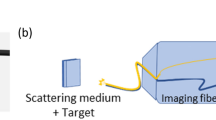Abstract
We have previously argued that an optical sensor combined total analysis system (TAS) is one of the indispensable functional components needed to realize a “ubiquitous human healthcare” system. To achieve this goal, we have proposed a fundamental structure for illuminating a minute cell or particle running along a microfluidic channel using a flat waveguide construction. It is desirable that the TAS light source should be arranged as close to the specimen flow as possible in order to acquire the necessary optical properties; hence, artificial defects formed on the surface of a flat light waveguide are considered to be a promising candidate for realizing the arbitrary-shaped light source for a highly functional optical TAS structure. Based on this idea, we fabricated a structure, constructing a flat and square light source consisting of rectangular solids, sub-micrometer in size, with a 1-μm thick and a 12-μm wide light waveguide core. We successfully trial-manufactured an optical TAS chip with a fluidic channel containing a 14 × 10-μm cross section, and an extremely flat light waveguide core. We repeatedly confirmed that the defect array could function as an approximately square light source when a 650-nm wavelength laser power was carefully introduced. Furthermore, we developed a hybrid numerical calculation method base on the finite-difference, time-domain method together with the beam propagation method. Utilizing this hybrid method, we evaluated the optical response when a particle runs across the light source while changing the aperture length of a shading mask to obtain signals with both higher intensity and shorter full width at half maximum. The numerical results were compared with experimental results obtained using an image acquisition system, and demonstrated good qualitative accord.
















Similar content being viewed by others
References
Gregor NF (2002) Device and method for investigating analysis in liquid suspension or solution. International application published under the Patent Cooperation Treaty (PCT), PCT/GB02/05567
Mapps T, Vannahme C, Schelb M, Lemmer U, Mohr J (2009) Design for optimized coupling of organic semiconductor laser light into polymer waveguides for high integrated biophotonic sensors. Microphotonic Eng 86:1499–1501
Mitasaki T, Senda M (2006) Write-once recording for multilayered optical waveguide-type holographic cards. Opt Soc Am 23(3):659–663
Ohkubo T, Hashimoto M, Hirota T, Itao K, Niwa T, Maeda H, Mitsuoka Y, Nakajimka K (2000) Mechanical characteristics of an optical flying-head assembly with visible light-wave guide flexure. J Inf Storage Process Syst 2:323–330
Ohkubo T, Terada N, Yoshida Y (2011) Minute particle detection using a light-wave-guide incorporated optical TAS (Total Analysis System). Microsyst Technol 17:849–856
Okagbare PI, Emoey LM, Datta P, Goettert J, Soper SA (2010) Fabrication of cyclic olefin copolymer waveguide embedded in a multi-channel poly (methyl methacrylate) fluidic chip for evanescence excitation. Lab Chip 10:66–73
Senda M, Aoki Y (2008) Identification data reproduction in multilayered optical waveguide-type holographic memory cards. Appl Opt 47(21):3973–3979
Sheridan AK, Stewart G, Ur-Reyman H, Suyal N, Uttamchandani DG (2009) In-plane integration of polymer microfluidic channels with optical waveguides—a preliminary investigation. IEEE Sens J 9(12):1627–1632
Takahashi N, Aki A, Ukai T, Nakajima Y, Maekawa T, Hanajiri T (2009) Electrophoretic mobility and resultant zeta potential of an individual cell analyzed by electrophoretic counter method In: Int symp semiconductor device research symposium (Washington, DC, December 2009), WP4-03
Vazquez RM, Osellame R, Nolli D, Dongre C, van den Vlekkert H, Ramponi R, Pollnau M, Cellulo G (2009) Integration of femtosecond laser written optical waveguides in a lab-on-chip. Lab Chip 9:91–96
Yagi S, Imai T, Ueno M, Ohtani Y, Endo M, Kurokawa Y, Yoshikawa H, Watanabe T, Fukuda M (2008) Pit distribution design for computer-generated waveguide holography. Jpn J Appl Phys 46(2):942–946
Yamada H, Yoshida Y, Terada N, Hagiwara S, Komatsu T, Terasawa A (2009) Laser fabrication of a micro-fluidic device for a blood cell counter. Proceedings of Autumn Annual Meeting, Japan Society for Precision Engineering G64:543–544
Acknowledgments
A part of this research was supported by a Grant-in-Aid for Scientific Research (category of general research field (C)), sponsored by the Ministry of Education, Culture, Sports, Science and Technology, Japan, since April 2011. This research was also partially financially supported by a Grant for the Program of the Strategic Research Foundation at Private Universities S1101017, organized by the Ministry of Education, Culture, Sports, Science and Technology, Japan, since April 2011. The authors would like to thank Dr. Makoto Hikita and Dr. Saburo Imamura, NTT Advanced Technology Corporation, for their useful and valuable technical advice in designing a resin-based light waveguide structure and fabricating a 10-μm-sized groove, and for their suggestions concerning a method for precisely observing a transparent light waveguide core structure under the high-magnification optical microscope. The authors also would like to thank Dr. Hidetaka Maeda, Sigma Koki Corporation, for his valuable advice and proposal concerning introducing laser power onto an extremely flat and thin light waveguide core of the optical TAS chip used.
Author information
Authors and Affiliations
Corresponding author
Rights and permissions
About this article
Cite this article
Ohkubo, T., Terada, N. & Yoshida, Y. Illumination and scattered light detection using a light source consisting of sub-micrometer defect arrays formed on a extremely flat light waveguide core. Microsyst Technol 20, 1413–1423 (2014). https://doi.org/10.1007/s00542-014-2132-9
Received:
Accepted:
Published:
Issue Date:
DOI: https://doi.org/10.1007/s00542-014-2132-9




